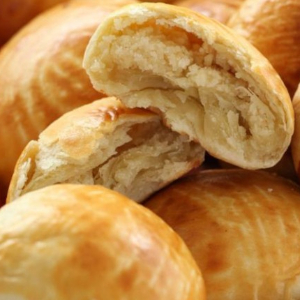Our taste buds and tummies have been touring Georgia, the heart of the Caucasus. Now it’s time to treat your sweet tooth! We’re poised to plunge into the world of Georgian sweets and deserts. And we’re also planning a side trip to the local pub for a quick Georgian pint or two…
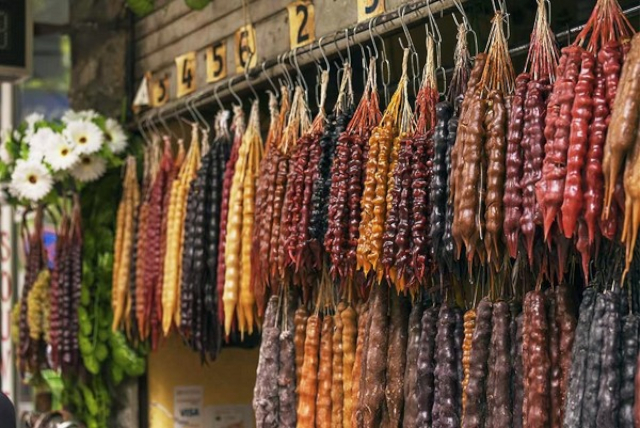 Churchkhela: The national candy of Georgia.
Churchkhela: The national candy of Georgia.
Georgia’s roots are largely rural, and their cuisine is simple though plentiful, but their legendary hospitality and love of a treat make up for what some light call a lack of culinary colour. And some of their favourite sweets are genuinely unique.
Churchkhela: As scrumptious as it is unpronounceable! This is the national candy of Georgia. It starts with a double length of plain cotton string on which are strung dried fruits, seeds or nuts. Then the assemblage is dunked repeatedly in a glaze called tatara, made from flour, sugar and fresh grape juice concentrate. Any colour is the right colour. Churchkhela are sold by armies of street vendors, and everybody loves them. Eat them like big, long lolipops!
Tklapi: This is a fruit leather particular to Georgia, one more colourful, more flavourful and easier to make than the gummy stuff we’re used to in the west.
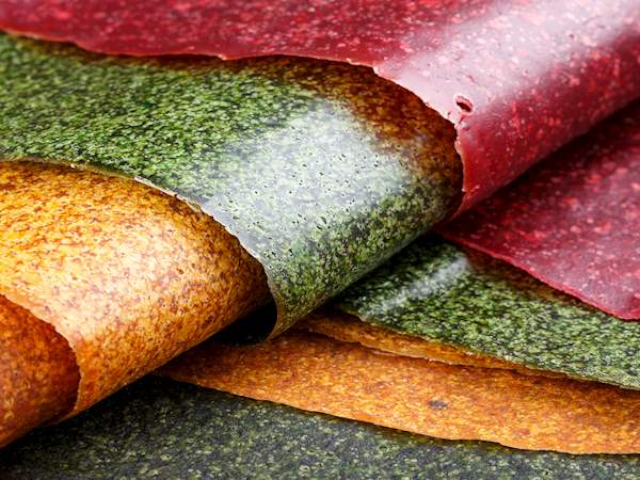
Fruit pulp is cooked as if it was going to be jarred for jam. Then it’s spread thin and left to dry until… it’s leather. It comes in every colour and flavour of the fresh fruit universe. Another great grab-and-go treat.
Pelamushi: Found at the top of almost every Georgian restaurant’s dessert menu. It’s a pudding made from concentrated grape juice and sugar simmered until it thickens. Then it’s poured into molds and cooled until it sets. Usually topped with chopped walnuts and pomegranate seeds.
Gozinaki: Could be the prototype for the energy bars we all know so well here in the West. Traditionally, they’re just nuts coated with honey and rolled out into flat slabs.
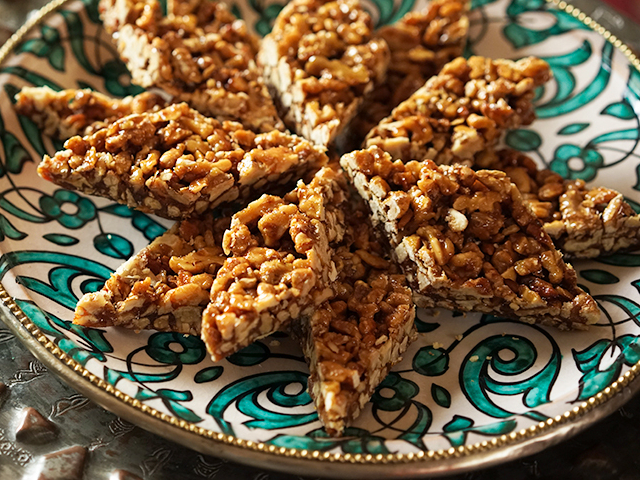
When set, they’re cut into diamond shapes or small bars. Available year-round in stores; usually home-made around Christmas.
Kada: Sort of a hand pie; sort of a candy; sort of a bread (see photo, top of page). But kids don’t care – they love ’em anyway. They’re simply made, of flour, butter and sugar and can be found in any bakery or café. Another great grab-and-go treat.
Medok: Georgian Honey Cake. It’s alternating layers of a rich sponge cake and a filling of vanilla cream. You can make it yourself, but cutting the hair-thin layers of sponge is something best left to the pros at the bake shop.
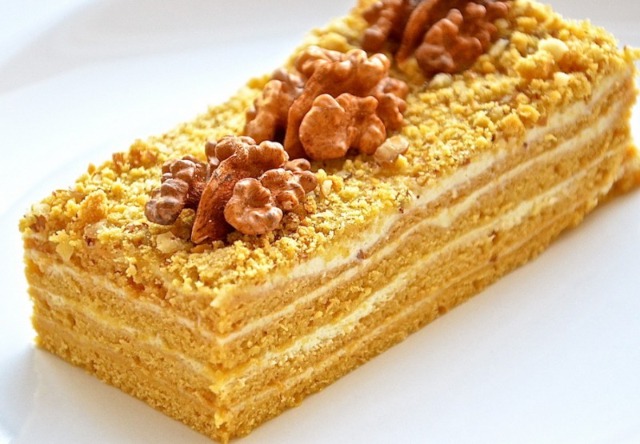
In case you do want to try, I’m including a link to an authentic Georgian recipe that spotlights the crucial details you need to be aware of when making both the cake batter and the filling. Garnish the finished cake with chopped walnuts and/or fresh fruit.
Nazuki: Spice Bread. Made with flour, water, sugar, butter and eggs. Flavoured with cinnamon, coriander, cloves and vanilla. It’s hand-formed into oval loaves and baked-off quick in the same clay oven as your daily Shotis Puri. The loaves are brushed with egg-yolk glaze just before baking.
Georgian Beverages, hard and soft…
Chacha: A beloved, ancient tradition. Apple Brandy. But made from the residue left after pressing apples for cider or juice.
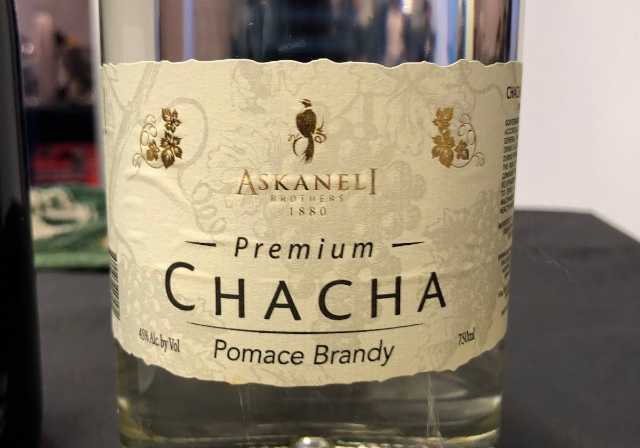 It’s called pomace, and it’s also widely used to make distilled spirits in France’s Normandy region. The Georgians have a nickname for pomace: chacha! It’s the official national drink.
It’s called pomace, and it’s also widely used to make distilled spirits in France’s Normandy region. The Georgians have a nickname for pomace: chacha! It’s the official national drink.
Wine: Georgia is known first and foremost for its wines. There’s story that – up to a few years ago when I heard it, at least – Georgian customs and immigration officials not only stamp your passport on entering the country, but present you with a bottle of wine!
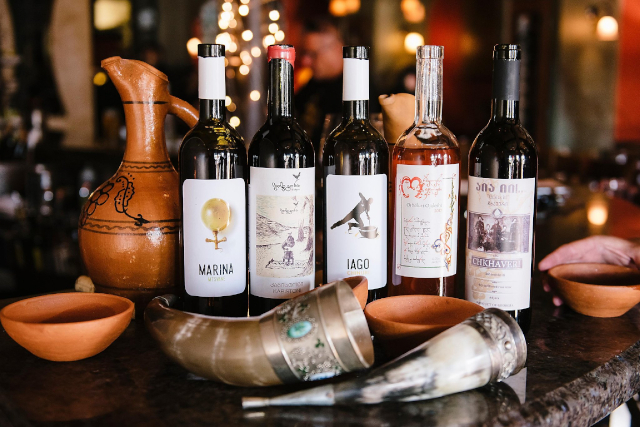
Wikipedia sums up Georgians’ relationship with their wine thus: “Georgia is one of the oldest wine regions in the world. The fertile valleys and protective slopes of the Transcaucasia were home to grapevine cultivation and neolithic wine production for at least 8,000 years. Due to the many millennia of wine in Georgian history and its prominent economic role, the traditions of wine are considered entwined with and inseparable from the national identity. […] In 2013, UNESCO added the ancient traditional Georgian winemaking method using the Kvevri clay jars to the organization’s Intangible Cultural Heritage Lists.”
You can’t get much more serious about wine than that! Georgian wines – especially the full, rich reds – are considered to be among the best in the region.
Tedo’s Marani: Georgian Honey Brandy. Originated by an ancient ancestor of the firm’s current hereditary head, the honey spirit is made according to the old recipe, which was revived in 1985 after 100 years gathering dust in the family cellars.

It was originally aged in barrels made by Tedo’s ancestor (who was also a woodworker) out of six different kinds of woods, giving the finished brandy a unique flavour.
Shkhivan: Georgian Gin. Joachim Tränkle – a German immigrant – formulated it from scratch after finding wild juniper berries growing along a walking path in the forest. The alcohol is made from grapes and the juniper berries are indigenous. The locals said the plant was useless, but Tränkle knew better! At 45 ABV, Shkhivan is pretty strong for the Western palate. It’s said to deliver aromatic and flavour notes of juniper, citrus, pepper, and grapefruit. And that’s just one of the products of the Tränkle family distillery: They also make award-winning fruit brandies like…
Fruit Brandies: A major feature of Georgian beverage culture. They’ll make brandy out of just about anything: Melons, Quinces, Apples and Mulberries are among the most popular.
What a way to top off our trip!
So… We depart the Republic of Georgia with a heavy heart and few more pounds on our hips. But with a big smile on our faces, after trying the country’s most famous foods and beverages! Who knows where in the world we’ll dine next!
~ Maggie J.

